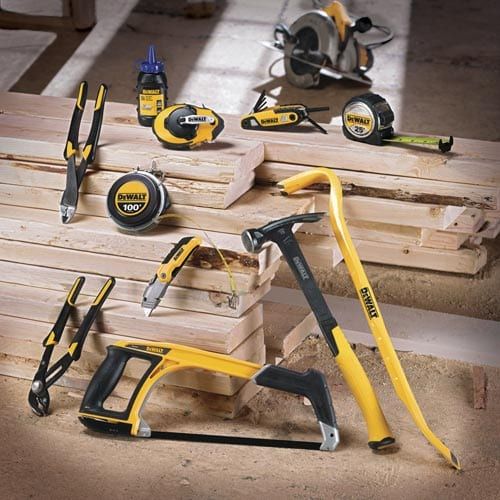
Building a basic toolbox is an essential first step for anyone interested in carpentry, whether you’re a beginner DIY-er or a seasoned professional seeking to consolidate your toolkit.
A well-equipped toolbox lets you tackle a wide variety of projects, from simple repairs to more complex builds. Knowing which tools are indispensable can save you time, money, and space.
Key Takeaways:
- Essential tools for a versatile carpentry kit.
- Recommendations for both power and hand tools.
- Maintenance tips to ensure tool longevity.
- Techniques and skills to enhance toolbox utility.
- Safety considerations for tool usage.
Table of Contents
Hand Tools: The Foundation of Your Toolkit

A fundamental toolbox begins with a core selection of hand tools. These are essential for their precision, control, and the need for less power, making them indispensable for fine work and detail.
Essential Hand Tools:
- Hammer: For driving nails and breaking apart materials.
- Screwdrivers: A set including various sizes and types, including flat-head and Phillips.
- Tape Measure: Crucial for accurate measuring and marking.
- Utility Knife: For cutting materials with precision.
- Chisels: For shaping and cutting wood joints.
- Squares: Allocating right angles and ensuring accuracy.
- Level: For ensuring everything is plumb and level.
- Saw: Handsaws like the traditional carpenter’s saw are vital for cutting lumber.
- Pliers: Locking, needle-nose, and wire-cutting pliers for manipulation and cutting of wire.
- Adjustable Wrench: For turning nuts and bolts of various sizes.
Understanding these hand tools’ uses aligns with basic carpentry techniques and is critical for anyone building their basic toolbox.
Power Tools: Enhancing Efficiency and Capability

While hand tools are crucial for fine control, power tools add speed and power to your carpentry arsenal, letting you do more with less effort.
Recommended Power Tools:
- Drill/Driver: Key for drilling holes and driving screws; consider a cordless model for convenience.
- Circular Saw: Perfect for making quick cuts on a variety of lumber sizes.
- Orbital Sander: For smoothing and finishing wood surfaces; refer to our guide on the best sanding machine for wood.
- Jigsaw: Allows for cutting curves and complex shapes in wood.
New to power tools? Check out our in-depth advice for first-time users on selecting and operating these devices in our power tools for beginners guide.
Measuring and Marking: Precision Ensures Perfection

Accurate measurements and clear markings are the foundation of successful carpentry work.
- Combination Square: Essential for multiple measuring tasks.
- Sliding Bevel: To replicate and transfer angles.
- Marking Gauge: For precise marking parallel to an edge.
- Carpenter’s Pencil: Stronger and more reliable than a standard pencil.
Develop your measuring and marking skills with additional information from our meticulous guide on measuring and marking.
Essentials for Joinery and Woodworking Tasks
Joinery is an intricate part of carpentry. Preparing to create joints and learning various techniques is facilitated by having the appropriate tools.
Joinery Tools:
- Saws: Dovetail saws for fine joints and tenon saws for deeper cuts.
- Chisels: For cleaning up the joints and other detailed work.
- Mallet: A non-marring hammer for chisel work.
- Wood Glue: For adhering wood pieces together securely.
Learn about creating strong, lasting wood joints with our article on woodworking joints.
Maintenance and Care for Your Tools

Maintaining the condition of your tools is as important as the initial investment. Here’s a quick guide on how to keep your tools in top shape:
- Cleaning: Regularly clean your tools to prevent rust and decay.
- Sharpening: Keep cutting tools sharp for efficiency and safety.
- Storage: Store tools in a dry place to avoid moisture damage.
- Inspection: Regularly inspect power cords and batteries.
Further details on keeping your tools ready for any job can be found in our guide on tool maintenance and care.
Safety Gear: Protecting Yourself While Working

While building your basic toolbox, never forget to invest in safety gear. Safety glasses, hearing protection, and durable gloves are non-negotiable inclusions for any carpentry project.
Check our tips on essential safety practices in carpentry through our extensive guide on carpentry safety fundamentals.
FAQ
What are the absolute essential tools for a beginner’s toolbox?
For a beginner, you will need at least the following: Hammer, Tape Measure, Screwdriver Set, Utility Knife, Chisels and Mallet, Saw, Drill/Driver, Level, Square.
How do I maintain my tools to ensure they last?
Regular cleaning, proper storage away from moisture, routine sharpening of cutting edges, and inspection for wear and tear are key steps in tool maintenance.
When should I use hand tools over power tools?
Hand tools should be used when you require more control and precision, such as in fine joinery work or delicate adjustments. Power tools are better for efficiency and labor-intensive tasks.
Are expensive tools always the better choice?
Not necessarily. While higher quality often comes with a higher price tag, it’s important to assess whether the tool fits your specific needs and whether you will use it enough to warrant the investment. Sometimes, mid-range tools provide the best balance between cost and performance.
Is it safe for beginners to use power tools?
Yes, with proper instruction, adherence to safety guidelines, and appropriate personal protective equipment, beginners can safely use power tools. Start with basic models and proceed to more complex tools as you gain confidence and skill.

